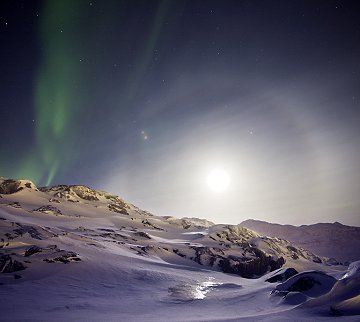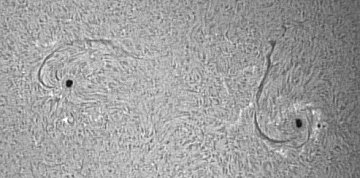 Did you sleep through the auroras of Dec. 14th? Next time get a wake-up call: Spaceweather PHONE.
Did you sleep through the auroras of Dec. 14th? Next time get a wake-up call: Spaceweather PHONE.
ASTEROID FLYBY: Mark your calendar. On March 31st, a 2-km wide asteroid named 2006 VV2 will glide past Earth. There's no danger of a collision: the space rock will be 8.8 times farther away than the Moon. The flyby is interesting because it is so bright, between 9th and 10th magnitude, making 2006 VV2 an easy target for backyard telescopes with CCD cameras. [3D orbit] [ephemeris]
OH, TO BE IN GREENLAND... "I went up the hill last night to take some photos of Nuuk, the capital of Greenland, but this moon halo caught my attention instead," reports Rune Christiansen. "Then, just as I was setting up my tripod, the auroras appeared."

Photo details: Canon EOS 5D, ISO 800, 15 sec, 17-40mm lens @ 17mm, f/4
Quiz: Which is closer, the moon halo or the auroras?
Answer: The halo is caused by ice crystals floating in thin, wispy clouds about 10 km above the ground. The auroras are caused by solar particles hitting Earth's upper atmosphere between 80 km and 500 km above the ground. So the moon halo is closer.
DOUBLE SPIRAL: Sunspots 940 and 941 are disappointingly quiet--no solar flares for days. But what they lack in spark they make up for in beauty. Both sunspots sit at the vertex of its own spiral filament. Emiel Veldhuis of Zwolle, the Netherlands, took this picture on Feb. 3rd:

Photo details: Coronado Personal Solar Telescope (PST)
The sunspots are each wider than Earth and their filaments stretch more than 150,000 km--all easy targets for backyard solar telescopes. Take a look!
more images: from Gary Palmer of Los Angeles, California; from Rogerio Marcon of Campinas - Sao Paulo - Brasil; from Alan Chaniewski of Marlborough, Ct.; from Masa Nakamura of Otawara, Tochig, Japan;

